How Many Draw Calls Is Too Many
AnyPortrait > Manual > Reduce Describe Calls
Reduce Draw Calls
1.3.v
One of the most effective ways to optimize your game'southward operation is to reduce Draw calls.
Draw calls are the number of times objects or other elements are rendered.
Shortly, the more than objects is located, the more draw calls will be.
All the same, depending on the rendering settings and the properties of the material, draw calls may decreases than the actual number of objects.
We recommend yous to refer the Unity, Community, and Forum articles on how to reduce draw calls.
This page contains scripts to compare AnyPortrait'southward power to reduce depict calls.
It also describes settings that increase draw calls in certain situations.
If you're using a script, see the Related page.
Note that.
In Unity, the describe call count is indicated equally Batch Count.
Although the two concepts have some processing differences, they are ordinarily about the same value, and 2 words are often treated as the same.
Delight annotation that these two words are also used every bit the same words on this page.
How AnyPortrait manages Depict Calls
AnyPortrait'southward systems offering a diverseness of features and optimization techniques to reduce depict calls.
1. The cases that the draw call is optimized or not increase
- Draw calls are optimized when the character's meshes are rendered with the same textures and materials.
- Draw calls are reduced when multiple characters are placed in the scene that share a common texture and material.
- Draw calls practise not increase even if the character's scale is negative.
- In script functions that change the color or texture of a mesh, if the target is "Prototype", the draw call is prevented from increasing within the grapheme. However, sharing depict calls with "other characters" will exist turned off.
2. The cases that the draw call increases
- Draw calls volition increase if meshes have dissimilar textures or different materials.
- Draw calls increase if colour animation is applied or if yous randomly change the color of a particular mesh with a script role.
- Draw calls may increase depending on depth from photographic camera. (Draw calls are reduced only when meshes of the same material are placed in succession.)
- When the clipping mesh is rendered draw calls increases, because is uses the Return Texture.
- If yous use a property other than the Shader belongings used by AnyPortrait, depict calls will increase.
AnyPortait has three draw call optimization steps.
1. Multiple characters are rendered with the minimum draw call
- It is that draw calls are the most optimized stage, and characters sharing the aforementioned cloth are rendered in the same depict phone call
2. Meshes of a single character are rendered with the minimum describe telephone call
- Depict calls are optimized inside a single character. Describe calls are not shared with other characters, but draw calls can be reduced a lot at this stage.
three. A mesh that does not share depict calls exists
- Depict calls increase because some of the meshes of a single graphic symbol are rendered in the unlike depict call.
Settings to optimize Draw Calls
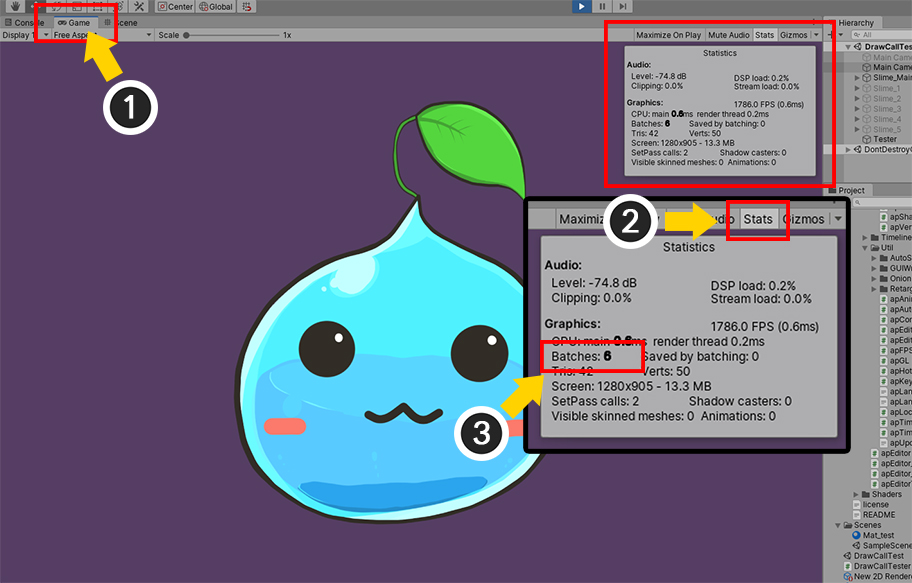
The simplest way to check describe calls in Unity is as above.
(ane) Select Game screen.
(ii) Press the Stats push button.
(3) The value of the Batches is the number of draw calls.
The scene to a higher place shows a scene where only i character is placed, and the draw call is 6.
There is no Describe call Batching, so all elements are being rendered on each depict call.
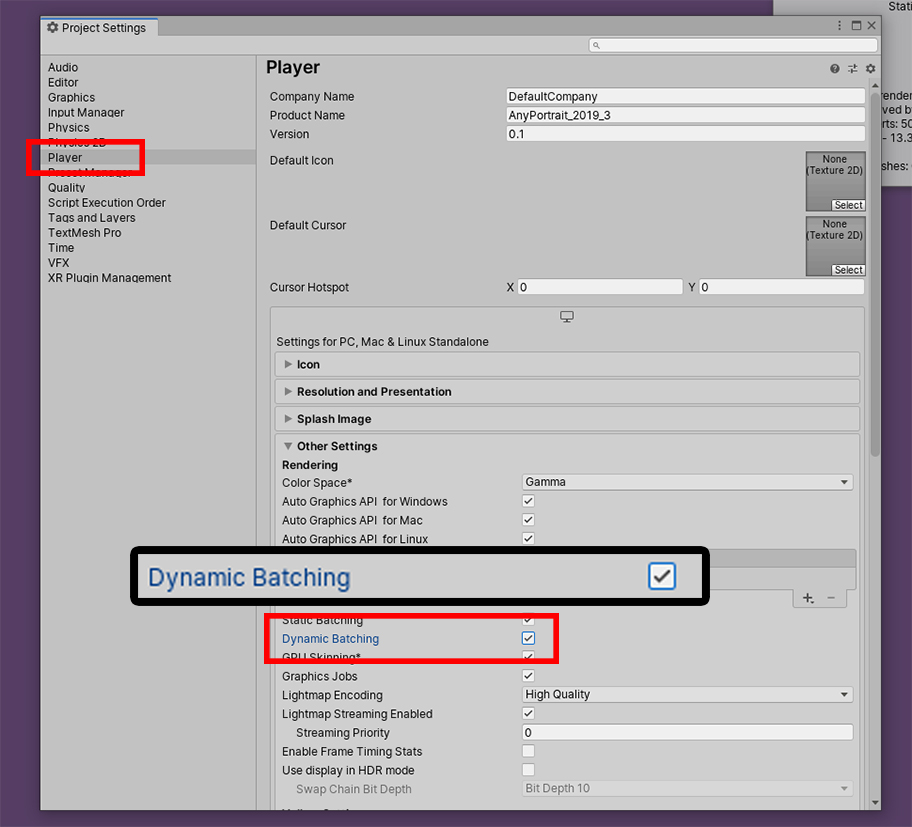
Open the Player Settings.
- Open "Edit > Project Settings" in the Unity card and select the "Player", or
- Select Player Settings from "File > Build Settings" in the Unity menu.
If Dynamic Batching is disabled among the items in Other Settings, describe calls are not optimized.
Plough on Dynamic Batching.
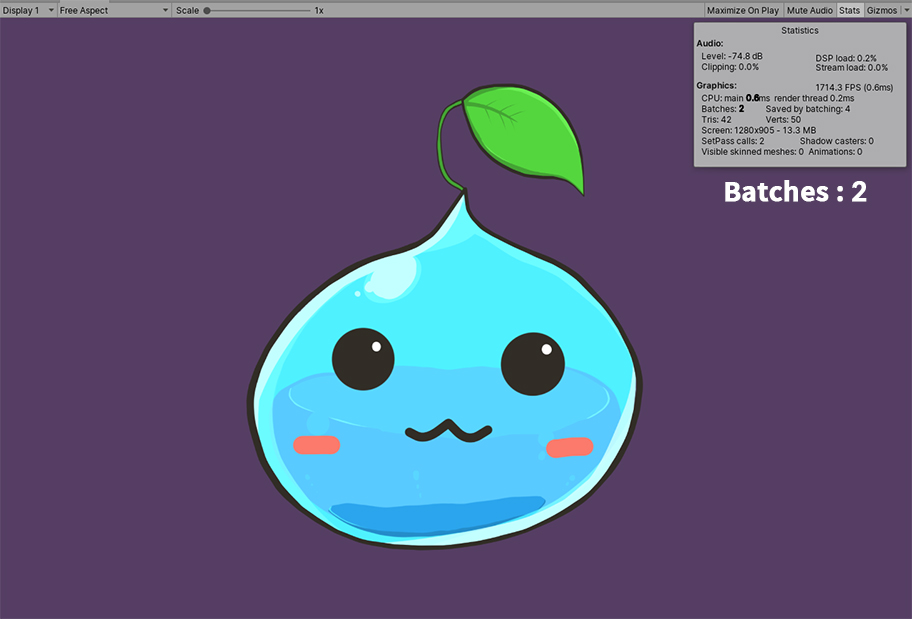
When yous run the game, draw calls are reduced from half dozen to 2.
(Draw calls are the sum past ane background and ane character with optimized meshes.)
Comparison of Depict Call changes according to how to set up the mesh color
When changing the colour of the mesh, the draw calls depend on which method y'all utilise.
This is related to AnyPortrait's draw phone call management.
See the example below to optimize.
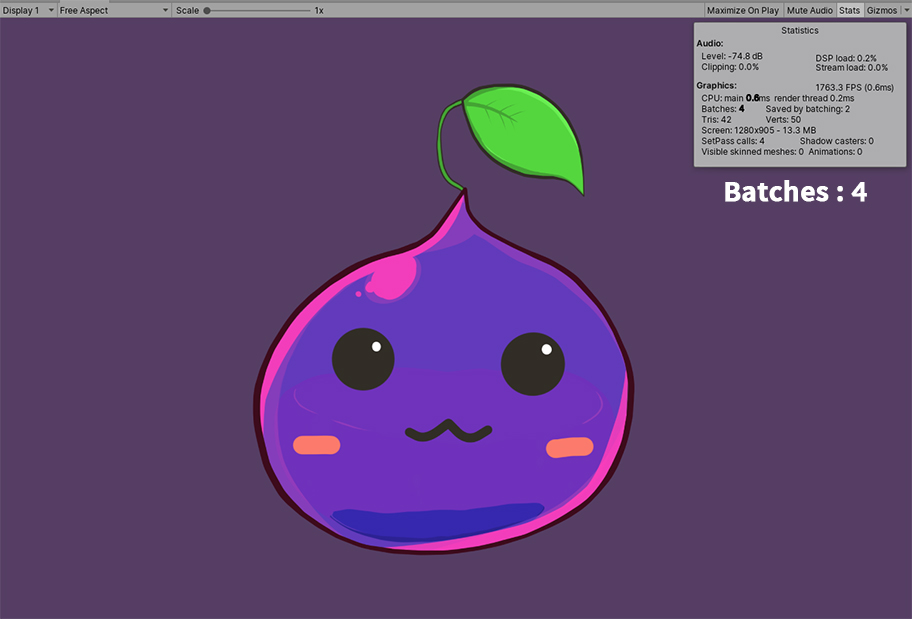
The colour of a mesh has been changed by a modifier or the "SetMeshColor(cord transformName, Colour color2X)" function.
In this example, this optimization phase is "lowest stages" that the draw calls are not shared with each meshes.
Draw calls increment to 4 because the color-changed mesh is rendered in dissever the describe telephone call.
Using the color animation is a comfortable mode to exercise this, only watch out for increased draw calls.
If the mesh'due south color returns to the default value equally (0.5, 0.5, 0.5, ane.0), draw calls are reduced,
and you can also optimize describe calls past using a function that restores the cloth settings,
such as "ResetMeshMaterialToBatch(cord transformName)".
Let's see what happens if the colors of the all meshes are changed in a batch.
Script functions that changes all the colors of meshes will mainly use two things:
- SetMeshColorAll(Color color2X) : Changes the colors of all meshes regardless of material.
- SetMeshColorAll(cord optTextureName, Colour color2X) : Changes the colors of the meshes, which are use the mutual texture, which is the argument.
These functions look almost identical, only there are differences in draw calls depending on how they are handled.
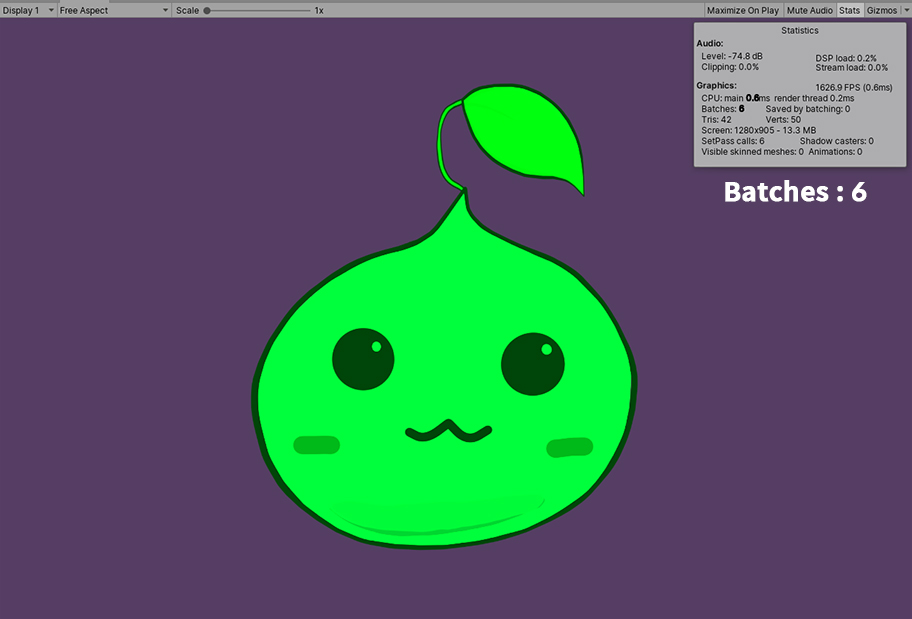
This is the result of using the SetMeshColorAll(Color color2X) function.
This function is aforementioned that the "SetMeshColor" function is applied to all meshes in bulk.
Since the SetMeshColor function is a function of the "everyman optimization stage", the mesh no longer shares the textile, regardless of color.
Therefore, the value the draw call is vi.
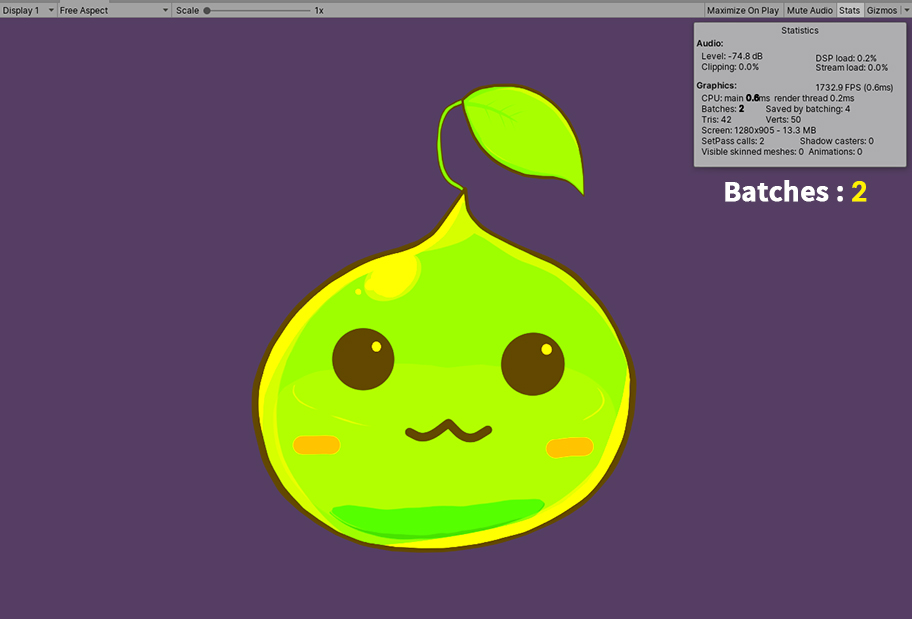
This is the result of using SetMeshColorAll(string optTextureName, Colour color2X) function.
Since we have given the name of the image as an argument, this function does non target "mesh", just "image".
Since this function directly modify the color of material shared past meshes, all meshes continue to share the same material.
Therefore, this function performs "Draw call optimization in single character" as "intermediate optimization phase".
Equally a result, the draw calls will remain at the optimized value of 2.
Comparison of Draw Call when multiple characters are placed

Draw calls increase when multiple characters are placed.
When various kinds of objects are placed, the draw calls generally increment by the number of objects.
Nevertheless, if only characters made with AnyPortrait are placed, the describe calls are greatly reduced if those characters share the same texture and material.
(If conditions are met, the original character does not necessarily demand to exist duplicated for optimization.)
In the above case, vi characters are placed in the scene.
All the same, with AnyPortrait's "highest optimization phase", you can run across that the draw calls are reduced significantly to 2.
If you practice not alter the color, use the default cloth backdrop and use the common texture, the characters created by AnyPortrait recognize each other and optimize draw calls without any actress work.
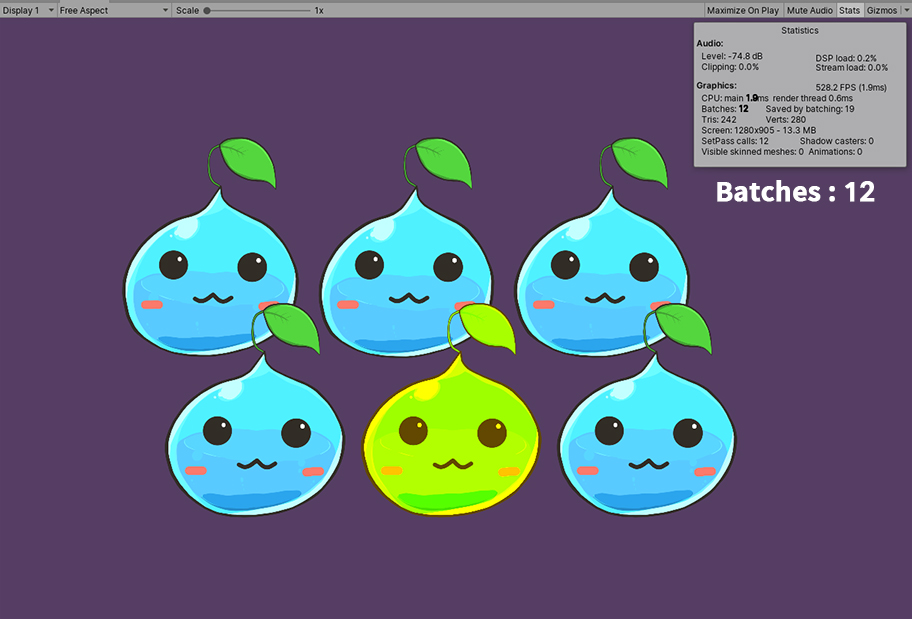
The screen higher up shows that 1 of the 6 characters is selected and the part SetMeshColorAll(string optTextureName, Color color2X) is applied.
Equally this office was used earlier, the "intermediate optimization phase", this character no longer shares the cloth with other characters.
Therefore, the draw calls increase from two to 12.
Of course, this value is pretty much less than expected maximum draw phone call of 31, which is the sum of the full number of meshes(30) and i background(i).
Nevertheless, it seems to have increased significantly compared to the most optimized value of 2.
This result is due to the "continuous rendering order", one of the weather nether which depict calls are batched and reduced.
Encounter additional caption below.
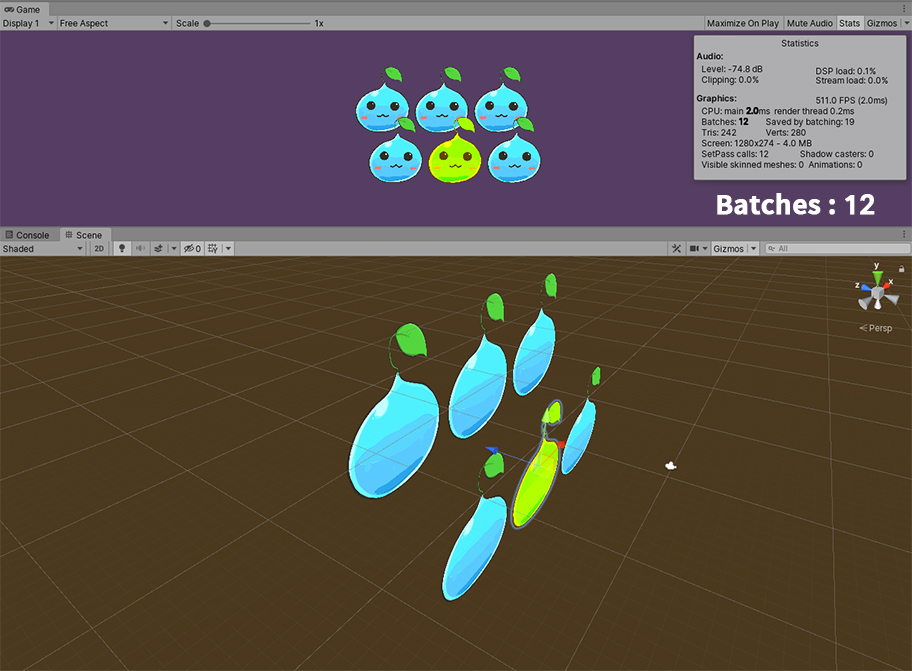
Let'south encounter how the characters are placed in the current scene.
The characters higher up are a bit behind, and characters in the aforementioned row have the same Z position.
Since the colour has the same Z position every bit the changed grapheme, the rendering order of the meshes of the dissimilar materials is mixed.
As a result, there are many situations where materials are switched while rendering is performed sequentially.
This situation does non effectively reduce draw calls even if several groups of objects share cloth.

Allow's encounter how the draw calls change by changing the Z position of the characters.
For simplicity, we tried to make sure that the Z positions are not equal but placed back and forth sequentially.
When rendering sequentially according to the Z position, this method prevents the rendering order of the "colour-changed characters" meshes and the rendering order of other meshes from being mixed.
The number of draw calls has been profoundly reduced from 12 to 4 again.
If you know this principle, yous can do a little more optimization.
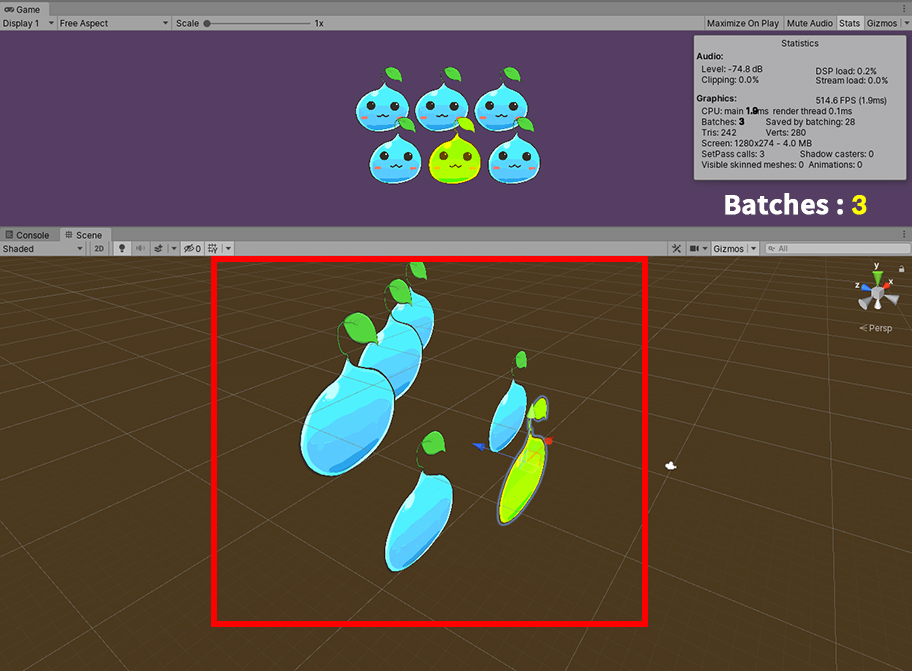
This time, the "color-changed character" is placed first.
The draw calls are now 3, which is the minimum expected value, because other characters are intentionally placed and so that they can be arranged and rendered at once.
This is the most optimized state, but in practice it is difficult to reposition objects to reduce draw calls in the game.
Instead, we recommend organizing your scene in such a way that depict calls are likely to be reduced.
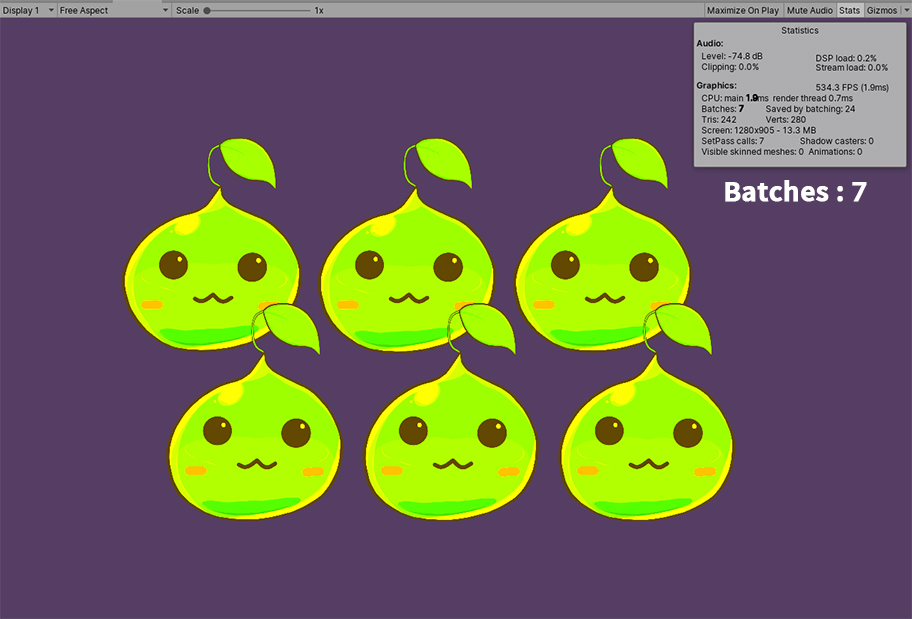
What happens if y'all employ SetMeshColorAll(cord optTextureName, Color color2X) to all characters?
Since this function is a "intermidiate optimization phase", once called, "Draw phone call optimization is a unmarried grapheme" is retained, merely "Draw telephone call optimization with other characters" is no longer performed.
Regardless of the color, the draw calls increase slightly to 7.
A value of 7 means that the Z positions of the characters are properly distributed (groundwork 1 + character half dozen),
as explained in a higher place, if the Z positions are the same and the rendering order overlaps, the worst case draw call may not exist optimized.
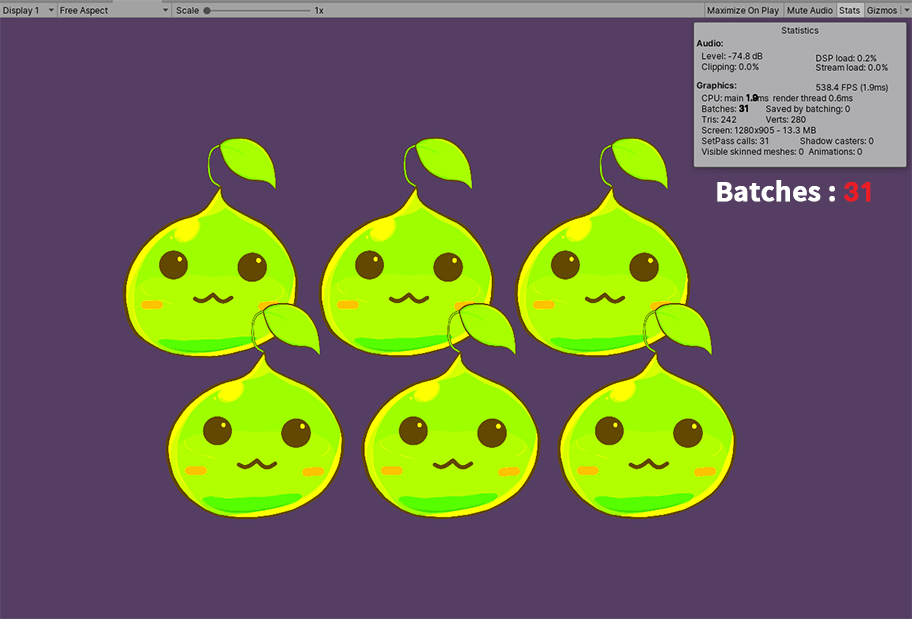
The screen above shows the characters are placed in the same Z position with other same conditions.
There are no draw call optimizations, reaching 31, which is a maximum.
Draw calls are internal adding of the Unity engine, so at that place are many other causes of increase and decrease in addition to the Z position.
Endeavor other means to optimize drawcalls.
Cases that can increase draw calls
There are many weather under which draw calls can be increased.
Below we introduce some features of AnyPortrait that increase the describe calls other than the to a higher place functions or color modifiers.

If multiple images are used for one character, the draw calls will increment.
It may be effective to apply i large paradigm rather than several smaller ones.
(Please bank check in advance since it may vary depending on the build surround and devices.)
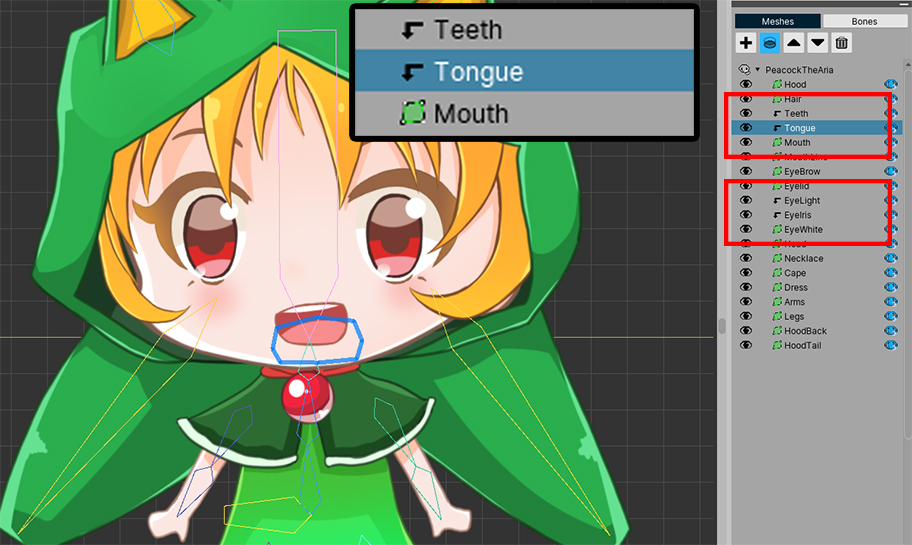
Clipping meshes use the Render Texture technique.
Due to the feature of the render texture technique, the clipping meshes does not share draw calls with other meshes.
Draw calls are increased for both clipping mask meshes and meshes existence clipped.
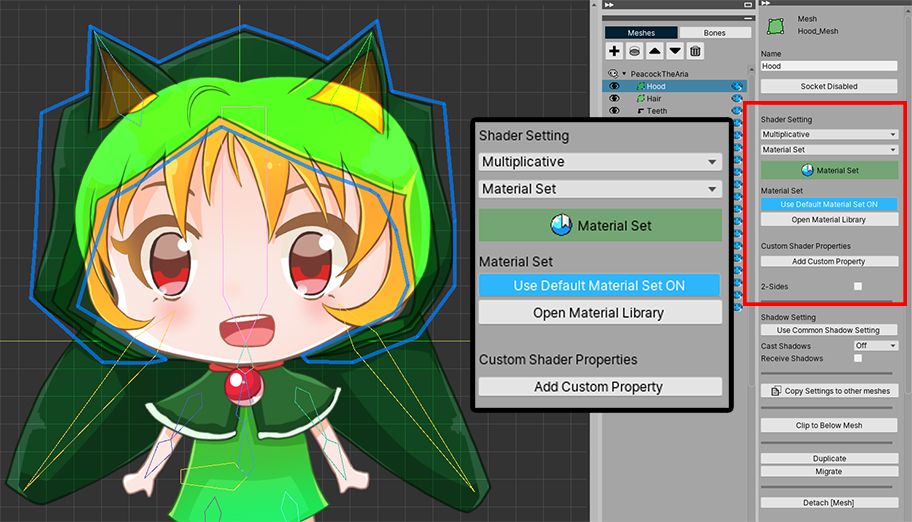
If you set up the mesh's Shader Settings to something other than the default, this mesh will non exist able to share the material with other meshes.
This mesh is inverse to be the "lowest optimization phase".
This is the case if you fix the Blend method to a value other than Alpha Blend, or use a Material Prepare that is different from the default.
Using the custom properties of the material using script functions (such as the SetMeshCustomFloatAll function) or the Add Custom Belongings function on this screen also causes an increase in draw calls.

If you lot cheque in the game, you can see that the draw calls are increased by some meshes.
Reducing Draw Calls using the Sorting Grouping
Despite the above caption, describe calls often increase.
In particular, information technology is difficult to reduce draw calls when many unlike characters or objects are placed.
If a large number of objects composed of Mesh Renderers announced like AnyPortrait, the depict call can increase significantly.
At this time, draw calls tin can be effectively reduced by using Sorting Grouping. (related page)
In item, this time, nosotros will use Unity's Frame Debugger to examine the rendering process in detail.
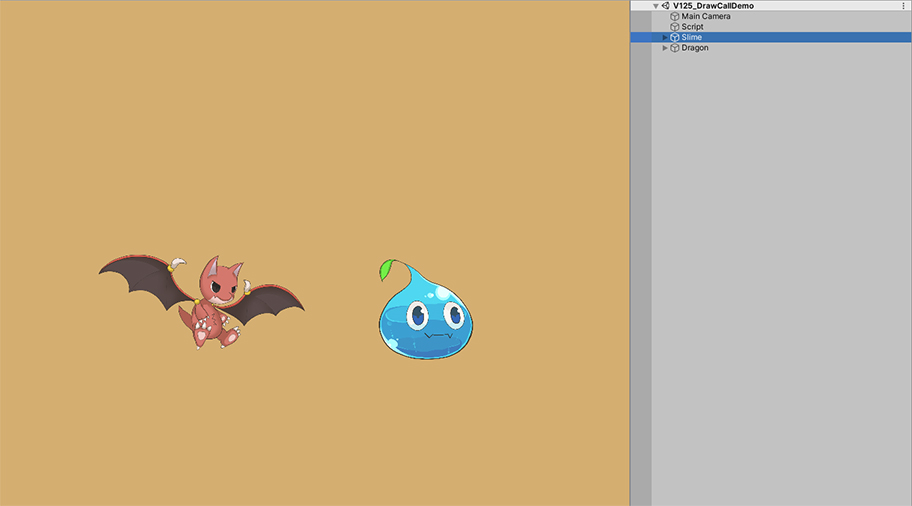
This is a scene where 2 types of characters are placed.
Both characters were created with AnyPortrait.
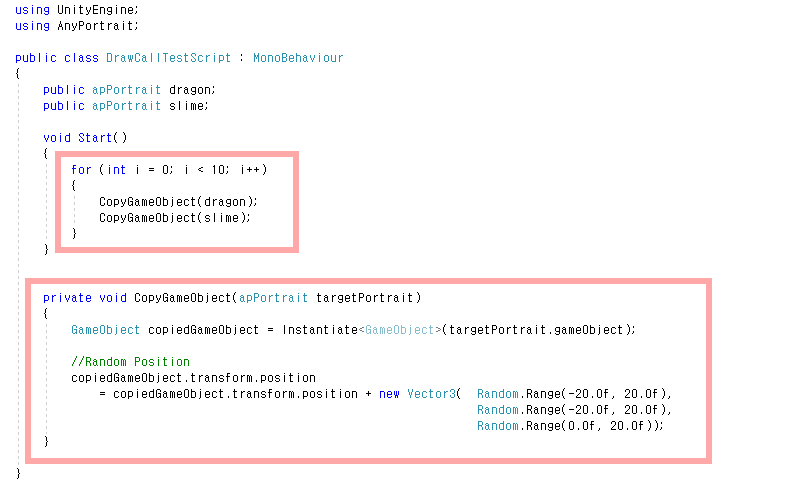
At the starting time of the game, a simple script was written that duplicated 10 more of the two characters.
This script makes the duplicated characters positioned within a range.
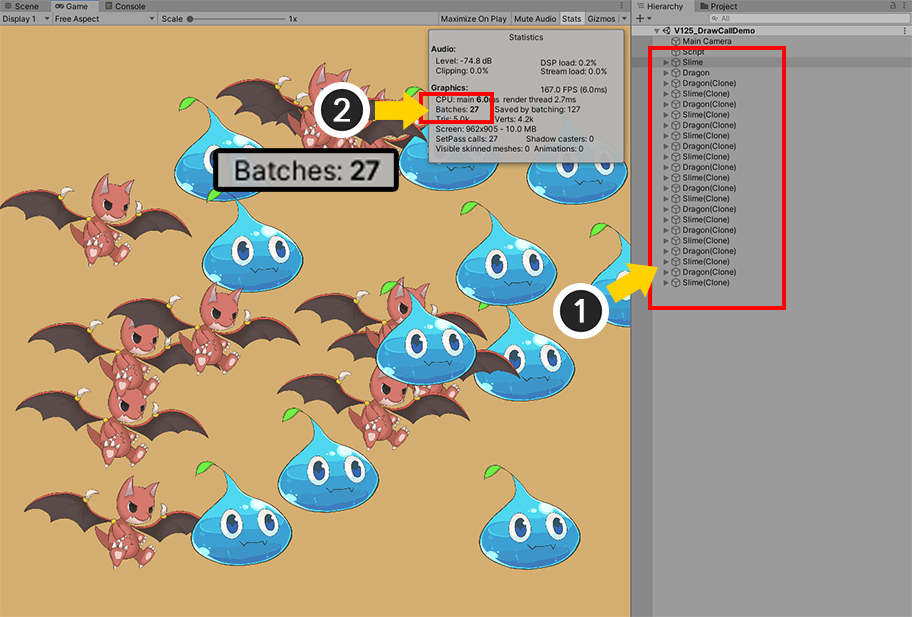
Permit'due south run the game.
(1) The characters are duplicated while the script is running.
(2) Describe call appeared as 27.
Since it is duplicated to a random location, the result is slightly different each time the game is launched,
It is very regrettable that every bit the character increases, the describe call is besides increased almost in proportion.
The duplicated characters are of the aforementioned material as the original, so it is good to share draw calls if possible.
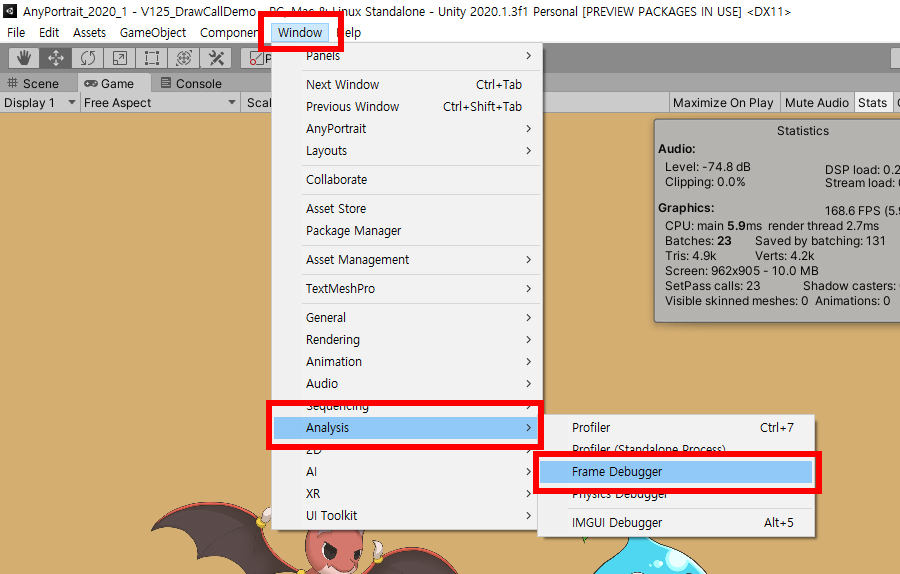
Let's run the frame debugger and check the rendering history.
Run Window > Analysis > Frame Debugger.
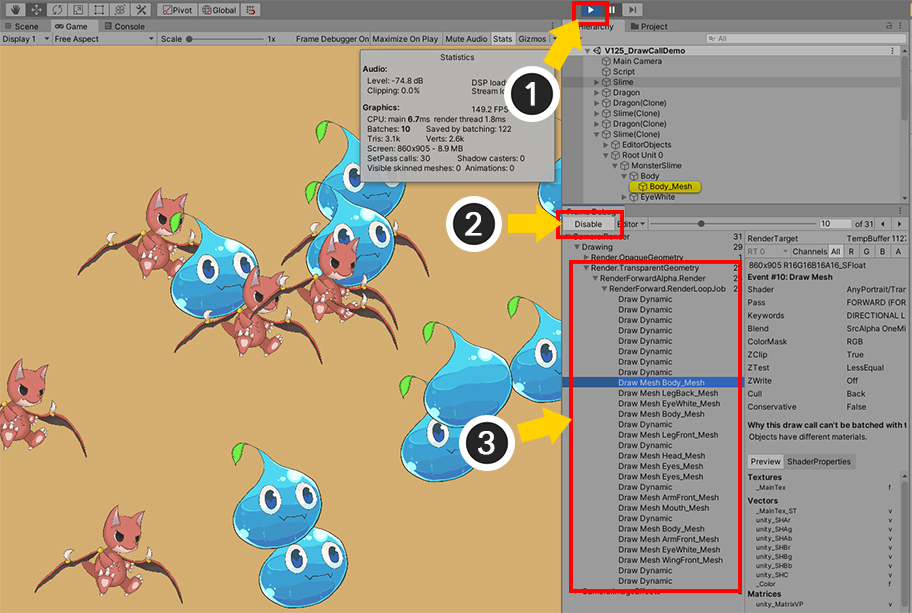
(1) Run the game and (2) click the Enable button.
(3) Information technology shows how the rendering has progressed in the current frame.

Since you need to check the mesh with translucent material, check "Drawing > Render.TransparentGeometry > RenderForwardAlpha.Render > RenderForward.RenderLoopJob".
(1) The gild in which the meshes were rendered appears. Draw Dynamic means that several meshes are rendered together in i describe call, and so it is somewhat optimized.
The problem is that respective meshes are rendered ane past one as shown in (2).
If yous see the above result, it means that meshes with different materials were rendered in order during the rendering process.
This is especially the case with AnyPortrait characters that consist of multiple meshes.
While each of the meshes is being rendered, the meshes of other characters with like Z values are mixed and rendered.
If yous use Sorting Group, you lot can forestall "rendering mixed with other character's meshes" as above.
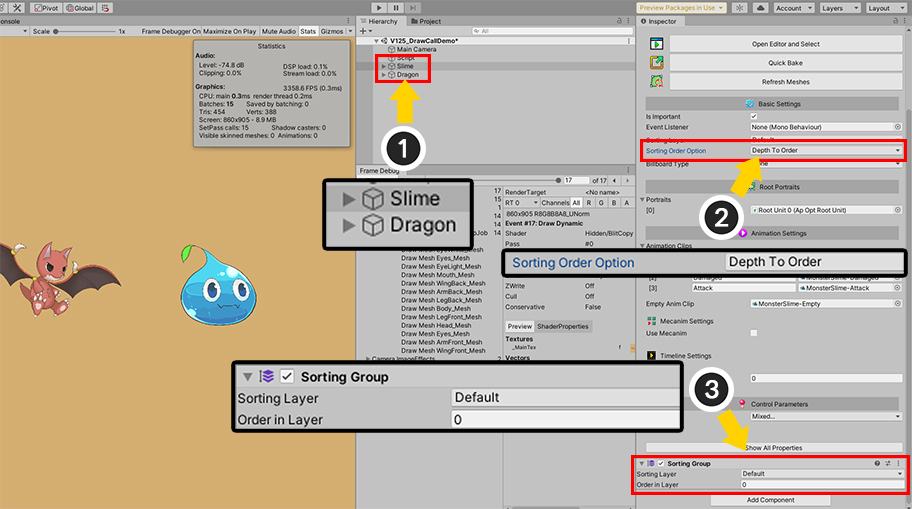
(1) Select each AnyPortrait character.
(2) Change the value of "Sorting Order Choice" to "Depth To Order".
(iii) Add the "Sorting Group" component.
(Yous can also add the Sorting Group component to the AnyPortrait character'due south parent GameObject.)

Run the game again and click the Enable button of the frame debugger to check the result.
(one) You lot can run across that all rendering steps are shown as Draw Dynamic .
Also, you lot tin run into that the draw call is greatly reduced because the rendering is performed in units of Sorting Group.
Draw calls take been reduced considerably, and the electric current optimization results are in skilful status for full general game projects.
Even so, it would exist nice if nosotros could reduce draw calls a piddling more than here.
This is because the current pace is "Rendering per Grapheme", but the most optimized step is " Rendering per Material ".
This optimization strategy tin can be difficult depending on the game, but it would exist a proficient thought to give information technology a endeavor if possible.

This method has the point that meshes with the same material can have the aforementioned draw call if they have their own rendering society for each character of the same blazon.
(1) Select one of the 2 characters. In this instance, the "Slime" character is selected.
(ii) In Sorting Grouping, change the value of (three) Order in Layer to " one " instead of the default value of 0.
If more than characters are added, set each graphic symbol blazon to take a different Sorting Order.
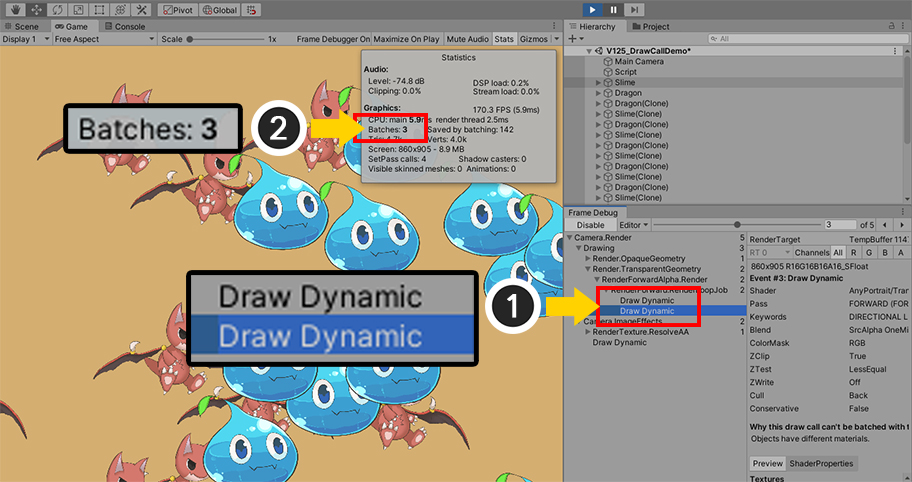
(ane) When you run the game and check the results in the frame debugger, you can see that draw calls have occurred as many equally grapheme blazon, not the number of characters.
(2) When the background is included, only depict phone call count of " 3 " occurred.
In this method, there is a problem that the rendering social club is fixed depending on the character type.
(In the image above, all Slimes are in front of all Dragons.)
However, if the rendering order is not important, and if there are a lot of characters, it is a good idea to try this optimization strategy.
Source: https://rainyrizzle.github.io/en/AdvancedManual/AD_ReduceDrawCalls.html
Posted by: byrdcasent.blogspot.com


0 Response to "How Many Draw Calls Is Too Many"
Post a Comment